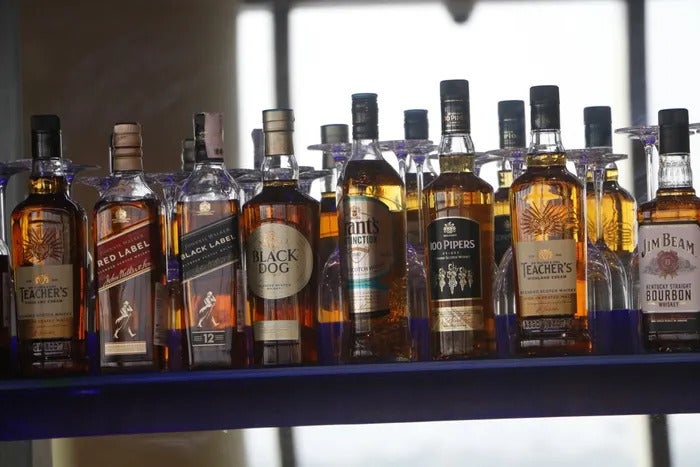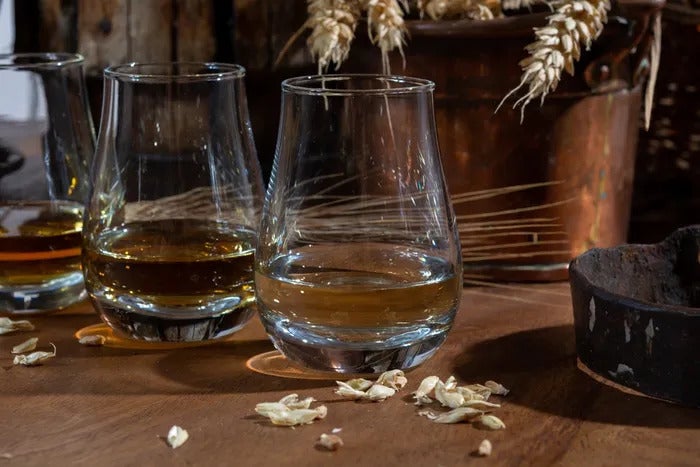There are no results that match your search.
Whisky • 6 min • 20.04.2023
Yamazaki Whisky and the Art of Japanese Craftsmanship

Japanese whisky is produced in Japan using Scottish methods, first produced in the early 20th century, and then quickly gaining a reputation for its quality and unique flavour profile.
Japanese Whisky vs. Other Whiskies
Japanese whisky is typically made using a blend of malted barley, which is mashed and then fermented using yeast. The resulting wash is distilled in pot stills, similar to the Scottish method, and then aged in oak casks for several years. The type of oak casks used, including American, Spanish, and Japanese oak, can influence the flavour.
The main characteristics between Japanese whisky and other world whiskies, including Scotch, are:
- High prolific distillery Producing several distinctive single malt characteristics
- Water source Quality of the natural spring in Japan
- Natural low-pressure distillation Low-pressure distillation is keeping a larger number of aromas and a thinner and lighter texture. Japan has three of the highest distilleries in the world; Karuizawa, Hakushu, and Mars Shinshu.
- Barley origin Japanese distillery import barley only from Scotland.
For a drink to be called "Japanese whisky," it must be fermented, distilled, aged, and bottled in Japan, use some portion of malted grain in its mash, and use water sourced from Japan.
The History of Yamazaki Whisky
Yamazaki whisky has a rich history that dates back a century, beginning in 1923, when Shinjiro Torii, the founder of Suntory (a multinational brewing and distilling company), began construction on the Yamazaki distillery in the outskirts of Kyoto, Japan. The Yamazaki distillery is considered one of the most prestigious and influential whisky distilleries that is often credited with popularising Japanese whisky and helping to establish it as a top contender in the global whisky market.
Torii was a visionary who was passionate about creating a unique and high-quality whisky that would rival the best in the world. He was inspired by the traditional Scottish methods of whisky-making but also wanted to incorporate Japanese ingredients and techniques. Torii hired Masataka Taketsuru, a young chemist and whisky expert, to help him develop his vision for a Japanese whisky. Together, they worked tirelessly to perfect the production process, experimenting with different grains, yeast strains, and cask types to create a uniquely Japanese whisky.
After several years of experimentation, Torii and Taketsuru finally launched Yamazaki whisky in 1929. The whisky was an instant success, with its smooth and complex flavour profile capturing the attention of whisky lovers around the world. Over the years, Yamazaki whiskies have won numerous awards and accolades, including the title of "World Whisky of the Year" in Jim Murray's Whisky Bible in 2014. This recognition has helped to cement the brand's reputation as one of the best in the world.
The Art of Making Yamazaki Whisky
The art of making Yamazaki whisky is a delicate and precise process that requires years of experience and expertise. The production process at Yamazaki is a combination of traditional Scottish methods and Japanese techniques.
The production of Yamazaki whisky begins with the selection of the finest ingredients. The distillery uses a blend of malted barley, as well as other grains such as wheat and corn, to create a mash that is then fermented using a unique strain of yeast developed specifically for Yamazaki.
After fermentation, the wash is distilled twice in copper pot stills, similar to the Scottish method, to create a pure and refined spirit. The spirit is then aged in a variety of oak casks, including Japanese oak, to add depth and complexity to the flavour profile.
The climate in Japan is also an important factor in the production of Yamazaki whisky, as the temperature and humidity levels can vary greatly depending on the region, which can impact the whisky's ageing process and final flavour. For example, higher temperatures can increase the effect that the wood of the cask has on the taste and even the amount of alcohol or water that evaporates from the final product.
The Types of Yamazaki Whisky
Yamazaki Single Malt 12/18/25-Year-Old Whisky
All of these prized whiskies are Suntory's flagship single malt whisky containing carefully blended components aged in American, Spanish, and Japanese Mizunara oak.
Yamazaki Single Malt 55-Year-Old Whisky
In its much anticipated first release of Yamazaki 55 Years Old, the House of Suntory pays tribute to the passage of time. Master Blender Keizo Saji was charged to bring his father’s dream to life, creating not only quality liquid gold but a quintessentially Japanese experience and lifestyle that rooted Suntory Whisky within Japanese culture.
Yamazaki whisky is the most sought-after and popular whisky in the world, but the supply of the whisky cannot meet the world's demand.
How Does Yamazaki Whisky Taste?
In general, Yamazaki has a pleasant garden of flowers aroma with a little tropical fruit and a nice nutty and Chinese herb note. While the golden liquid runs down your throat like a sweet and silky spice, it finishes you off with a subtle hint of orange peel and oak.















